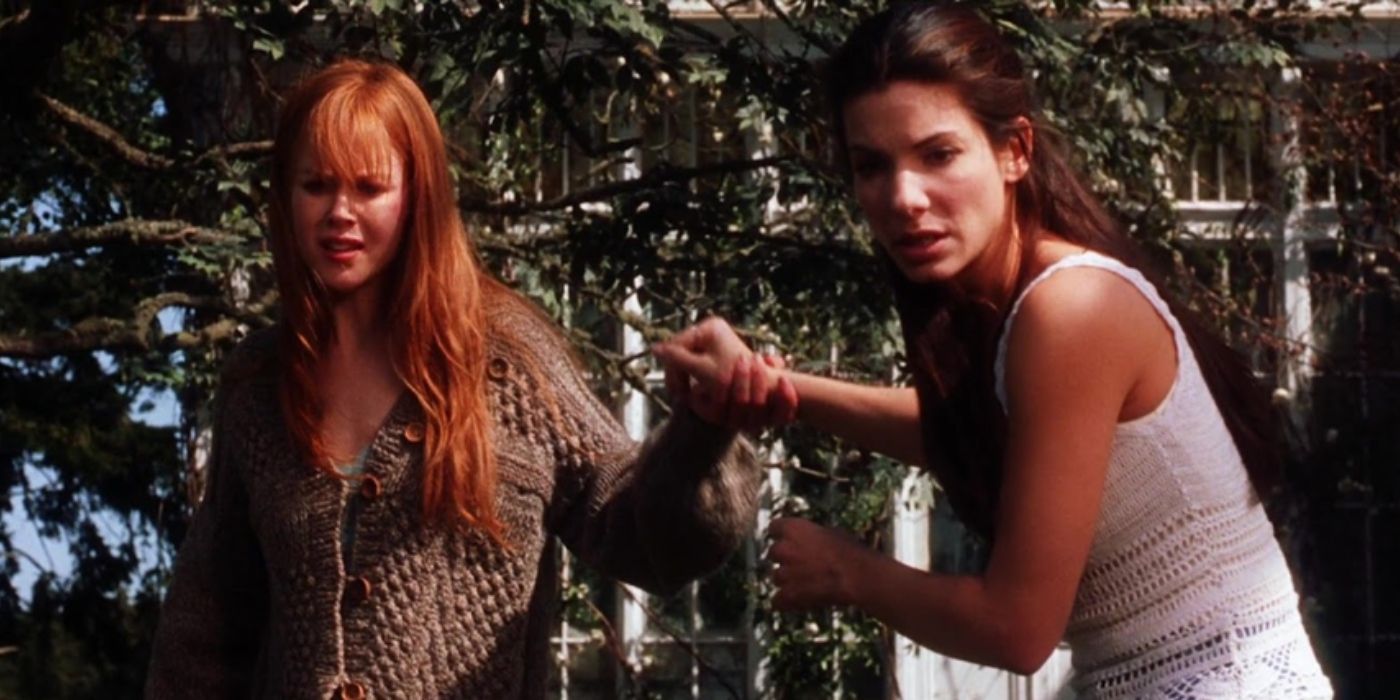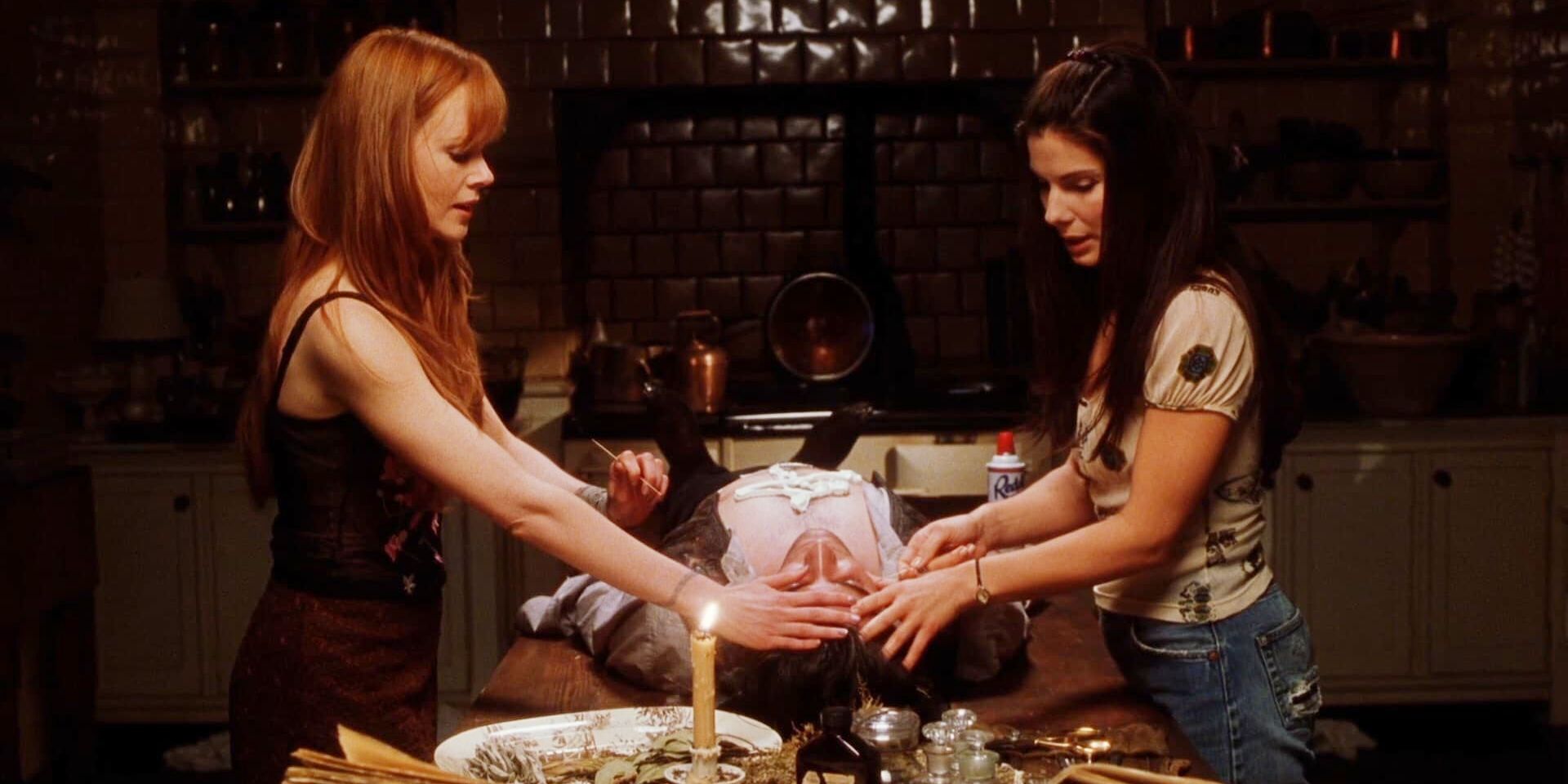Practical Magic has become a Halloween classic since its 1998 release, when it was adapted from the 1995 novel of the same name written by Alice Hoffman. The film features Sandra Bullock and Nicole Kidman in starring roles as Sally and Gillian Owens, sisters who come from a long line of Massachusetts witches. Practical Magic offers a heartwarming look at the enduring bonds of sisterhood, while including campy horror and whimsigothic aesthetic choices. However, despite its generally uplifting tone, Practical Magic has a dark connection to some horrifying real history.
The film’s opening scene reveals that Owens family matriarch Maria Owens narrowly escaped the Salem Witch Trials, where she was condemned to death after having an affair with a married man. After surviving and accepting banishment to a remote island, her lover never returns to her, and she casts a spell on herself to never fall in love again, sparking a generational curse upon any man who loves an Owens woman in her family line. While this constitutes a key plot point, it also links the movie with one of the darkest and most brutal chapters in American history.
How Practical Magic Incorporates The Salem Witch Trials
The Owens Family Ancestor’s Persecution Still Speaks Volumes Today
The Salem witch trials are referenced in the opening scene, and settle one of the central themes of the film – that women are often used as a scapegoat in societies dominated by men. The film was shot on Whidbey Island, Washington, but the story is set in Massachussetts, a state with a rich American history and the site of the Salem witch trials. The opening scene does depict period accurate Puritan settler costumes, and the women convicted of witchcraft were sentenced to death by hanging from 1692-1693.
While not filmed in Massachusetts, some of Whidbey Island’s Victorian era architecture does mirror the overall historic preservation of several local communities in Massachussetts, though the state tends to boast more Colonial era than Victorian architecture. While Maria Owens’ story is fictional in Practical Magic, the Salem witch trials did primarily prosecute women (except five men). None of the accused were banished to nearby islands, but instead taken to the Boston Gaol, the city’s primary prison at the time. Historians have since confirmed that many died in prison due to the poor conditions (per the Salem Witch Museum).
The Real History Of The Salem Witch Trials
Teenage Girls Lead the Charge In Accusing People Of Witchcraft, Though Few Young Women Were Executed
Witch trials date back to the Middle Ages in Europe, when victims were drowned or burned at the stake. They sprung from the Catholic Church’s warnings against witchcraft, and the Spanish crown’s Inquisition, which targeted heretics and witches alike (essentially, anyone who did not subscribe to the status quo – via Cambridge University). According to Trinity College, thousands of women were executed across Europe from 1300-1800. Historians believe witchcraft allegations were born from the biblical creation story that Eve was the perpetrator of original sin after eating the forbidden fruit, and the general teachings that women were the weaker sex (per the UK National Archives).
Centuries later, in Salem, Massachusetts, the religious fervor remained, as the Puritans perpetrated brutal executions due to their strict sect of Christianity. Puritans sought to reform the Church of England to more strictly adhere to the Bible. Religion aside, the rumors swirling around witchcraft were largely born out of land disputes and neighborly feuds, often involving women property owners. 12-year-old Ann Putnam and several other tween girls sparked the inquisition by blaming nightmares and mystery illnesses on witchcraft, beginning with an enslaved woman named Tituba (per Smithsonian).
The Salem Witch Museum also confirmed that one male victim named Samuel Wardwell was convicted of being a fortune-teller for his tradition of guessing the sex of unborn babies to couples in Andover, Massachusetts, close to Salem. The biggest difference between popular media portrayals of the trials (including Arthur Miller’s the Crucible) and the true story is that few young women were executed, with the youngest victim being in her late 30s.
How This History Ties Into Practical Magic’s Themes
The Film’s 1990s Setting Proves That Misogyny Was Always The Enemy In The Witch Trials
After Gillian and Sally lose their parents to the Practical Magic curse, they are raised by their Aunts Frances and Jet, who encourage them to use magic for good, as they often do to help the women of their community. However, the young girls soon face intense bullying and ostracization from their peers over their family’s reputation for being witches. This prompts Sally to vow to never use magic, as she fears judgment from her community. The isolation the girls experience is emblematic of the societal treatment of women who dare to innovate or not live a conventional lifestyle, even in the film’s contemporary setting.
The film uses the history of witchcraft to illustrate that women are frequently punished for being different or innovating new solutions…
While the Owens women are not targeted for land ownership or predicting the sex of their neighbors’ unborn babies like in the real Salem, they are criticized for their unique way of life, from their herbal practices to literal magic and living within an all-women community. The film uses the history of witchcraft to illustrate that women are frequently punished for being different or innovating new solutions, or for the downfall of men in their lives.
Such is the case when Sally Owens loses her husband to the curse, and the townsfolk immediately suspect foul play. One of the most heartwarming aspects of the film is that she soon falls in love with handsome detective Gary Hallet (who she dreamed up as a spell as a child, as she figured an imaginary man could not be afflicted by the curse). Gary is immediately taken with the Owens’ unique way of life, instead of being threatened by it. Even the film’s rom-com elements point to the same truth – that misogyny was the real witch hunt in Practical Magic and beyond.
Sources: Salem Witch Museum, Cambridge University, Trinity College, UK National Archives, Smithsonian





